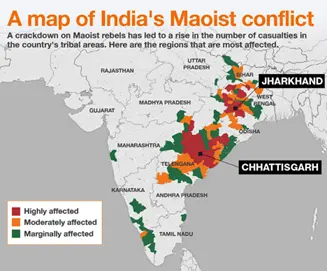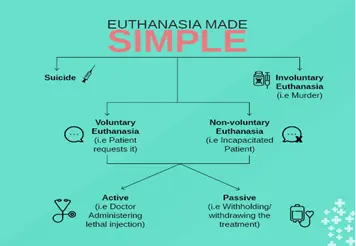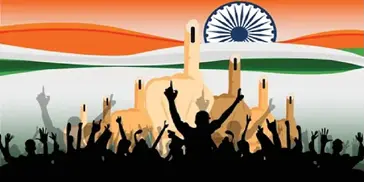Tuesday, 27th August 2024
MUDRA 2.0 Loans Should Target Greater Equity, Deepen
Why in the news?
- Launched in 2015 by the Narendra Modi government, the Pradhan Mantri MUDRA Yojana (PMMY) aims to foster entrepreneurship in India.
- The scheme offers collateral-free micro-loans up to ₹10 lakh, targeting small and micro-enterprises and contributing significantly to the grassroots economy.
- As the next phase, MUDRA 2.0, is anticipated, evaluating the successes and challenges of MUDRA 1.0 is crucial for enhancing future initiatives.
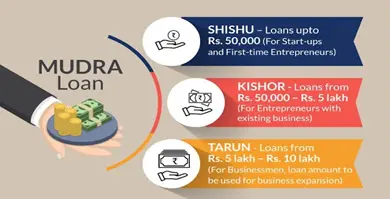
Successes of MUDRA 1.0
- MUDRA 1.0 has successfully disbursed over ₹27.75 lakh crore to 47 crore small and new entrepreneurs, greatly impacting India’s grassroots economy.
- The scheme has been instrumental in providing financial support to individuals previously excluded from formal credit systems, promoting economic inclusivity.
- Approximately 69% of MUDRA loan accounts are held by women, and 51% are owned by entrepreneurs from SC/ST and OBC communities.
- This focus on marginalised groups has fostered gender equality and social equity, enhancing participation in economic growth.
- MUDRA 1.0 has contributed to job creation, especially in rural and semi-urban areas, by encouraging self-employment and supporting small businesses, thus reducing unemployment and improving economic opportunities for underserved communities.
Challenges Faced by MUDRA 1.0
- Unequal Distribution of Credit:
- Despite the scheme's inclusivity goal, loan disbursement was uneven, with more developed districts receiving disproportionate amounts.
- For instance, in FY 2021-22, the top 10 districts received over ₹26,000 crore in loans, equivalent to the total sanctioned for the bottom 318 districts combined.
- This disparity shows that rural and remote regions, meant to be the primary beneficiaries, lagged in accessing MUDRA loans.
- Inadequate Monitoring and Implementation:
- Poor monitoring undermined the scheme’s effectiveness, leading to a loss of trust among beneficiaries and financial institutions.
- Although the overall NPA ratio decreased from 3.61% in FY21 to 2.1% in FY24, loans in the Kishore and Shishu categories (₹50,001 to ₹5 lakh and up to ₹50,000, respectively) accounted for over 75% of bad loans from FY20 to FY22.
- Limited Financial Literacy Among Beneficiaries:
- With only 27% of India's population being financially literate, many MUDRA beneficiaries lacked skills in budgeting, saving, and planning for loan repayments.
- This lack of financial literacy resulted in financial mismanagement and defaults, particularly among early-stage entrepreneurs.
- High NPAs in Key Categories:
- The Kishore and Shishu loan categories experienced high NPAs, with the Kishore category consistently having an NPA percentage above 4% from FY20 to FY22, higher than the average across all loan categories.
- This issue was due to borrowers' lack of business acumen and experience, alongside broader systemic issues such as inadequate support and mentorship.
- Insufficient Credit Guarantee Mechanism:
- The lack of a robust credit guarantee mechanism made banks hesitant to lend to small and micro-entrepreneurs, particularly high-risk borrowers.
- This absence of a safety net constrained credit flow and exacerbated the uneven distribution of loans between urban and rural areas.
Proposed Changes for MUDRA 2.0 to Address Challenges
- Focused Outreach and Empowerment Zones:
- Establishing Focused Outreach and Empowerment Zones in rural and semi-urban areas is crucial.
- These zones will provide financial services, including micro-loans, savings accounts, and insurance products, to better reach traditionally excluded populations.
- Nationwide Financial Literacy Programs:
- A nationwide initiative to enhance financial literacy among micro and small entrepreneurs should be a cornerstone of MUDRA 2.0.
- The curriculum would cover interest rates, cash flow management, tax preparation, and savings and investment, with special emphasis on digital financial literacy.
- Enhanced Credit Guarantee Scheme (ECGS):
- MUDRA 2.0 should incorporate an ECGS to reduce risk for financial institutions, encouraging them to extend more credit to target beneficiaries.
- The ECGS would offer a credit guarantee to banks covering a significant portion of the loan amount in case of default, making lending more feasible for high-risk borrowers.
- Robust Monitoring and Evaluation Framework (RMEF):
- Implementing a RMEF is essential for ensuring transparency, efficiency, and effectiveness.
- This framework would use technology to monitor loan disbursements, utilisation, and repayments in real-time, identifying and addressing issues early.
Conclusion
While MUDRA 1.0 has made significant progress in promoting entrepreneurship and economic inclusivity, its challenges highlight the need for a more comprehensive approach in MUDRA 2.0. By expanding its scope, enhancing financial literacy, introducing improved credit guarantees, and implementing a robust monitoring framework, MUDRA 2.0 can build on the successes of its predecessor and address its shortcomings.
Source: IE
India Targets Doubling Trade with Africa by 2030
Why in the news ?
- Recently, at the 19th India-Africa Business Conclave organised by the Confederation of Indian Industry (CII) in New Delhi, India announced an ambitious plan to double its exports to African countries to USD 200 billion by 2030.

How Will India Double Its Exports to African Countries?
- Targeting High-Growth Sectors:
- Agriculture and Agro-Products: Indian firms will aid Africa in boosting food production through advanced technologies and agro-processing methods, with bilateral trade reaching USD 100 billion in 2022.
- Pharmaceuticals: With exports at USD 3.8 billion in 2023, India aims to expand its role in providing affordable medicines and healthcare.
- Automobiles: India plans to boost exports of vehicles, especially two-wheelers and affordable cars, to meet rising African demand.
- Renewable Energy: India and Africa aim to lead in renewable energy, particularly solar power, with the "One World, One Grid" vision connecting energy grids. More than 20 African countries are part of the International Solar Alliance (ISA).
- Logistics and Transportation: India will share its PM Gati Shakti master plan and Unified Logistics Interface Portal (ULIP) to improve logistics and multimodal connectivity. The African Continental Free Trade Area (AfCFTA) highlights automobiles and logistics as key collaboration areas.
- Unified Approach to WTO Reforms: India seeks a unified African stance on WTO reforms, focusing on food security, agriculture, and technology transfer to address protectionist trade barriers.
- Duty-Free Tariff Preference and FTAs: India offers Duty-Free Tariff Preference (DFTP) to 27 Least Developed Countries (LDCs) in Africa and is exploring new Free Trade Agreements (FTAs) to boost trade and diversify goods.
- Strategic Cooperation:
- Support for African Union: India supports the African Union’s full G20 membership to elevate African voices globally.
- Special Economic Zones (SEZs): India encourages investments in Africa’s manufacturing zones and expanding SEZs to strengthen economic ties.
- Global South Representation: India aims to lead advocacy for the Global South, promoting inclusive growth and strengthening the position of developing nations, including those in Africa.
Current Trends in India-Africa Trade:
- Trade :
- Bilateral trade between India and Africa grew by 9.26% in FY 2022-23, reaching approximately USD 100 billion.
- Exports totaled USD 51.2 billion, and imports amounted to USD 46.65 billion.
- In FY24, India exported goods worth USD 38.17 billion to Africa, with major destinations including Nigeria, South Africa, and Tanzania.
- Key exports included petroleum products, engineering goods, pharmaceuticals, rice, and textiles.
- The African Union is India’s fourth-largest trading partner, after the United States, China, and the United Arab Emirates, with Nigeria being the top trading partner within the African Union, accounting for 20.91% of trade.
- Import Composition: India's imports from Africa are mainly primary products and natural resources:
- Fuels: 61% of imports, primarily crude oil from Nigeria, Angola, and Algeria.
- Precious Stones and Glass: 20%, sourced from Ghana, South Africa, and Botswana.
- Vegetables, Metals, and Minerals: Sourced from Benin, Sudan, Zambia, South Africa, Morocco, and Côte d'Ivoire.
- Export Composition:
- Fuels: 20%, including non-crude petroleum oil to Mozambique, Togo, Tanzania, Kenya, and South Africa.
- Chemicals: 18.5%, including pharmaceuticals to Nigeria, Egypt, and Kenya.
- Machines and Electricals: 12.59%, exported to Nigeria, South Africa, and Egypt.
- Economic Investments: India has invested over USD 12.37 billion in 206 infrastructure projects across 43 African countries, positively impacting millions of lives.
Challenges for India-Africa Trade:
- Non-Tariff Barriers:
- Indian agricultural exports face obstacles due to the EU’s food safety standards, affecting products like chilies and basmati rice.
- These standards impact trade with African nations aligned with EU regulations.
- Advocating for relaxed standards can enhance trade and competitiveness in both markets.
- WTO Reforms:
- The 13th WTO Ministerial Conference failed to reach consensus on issues like agriculture and technology transfer, affecting developing nations, including Africa.
- Lack of reform in subsidies and tariffs hampers African competitiveness and imposes barriers on Indian exports.
- Unresolved WTO issues can damage Indian product reputations in African markets compared to Chinese goods.
- Debt Concerns:
- Rising debt in sub-Saharan Africa, nearly doubling in the past decade, creates economic instability.
- Many low-income countries face or are at risk of debt distress, challenging India-Africa trade.
- Chinese Influence:
- China’s dominance in sub-Saharan Africa, including substantial exports and manufacturing, creates an uneven playing field.
- Criticisms of China’s debt diplomacy and lack of standardised debt documentation further complicate trade dynamics for India.
Way Forward
- Trade Agreements: Expanding agreements like the India-Mauritius CECPA is essential for boosting trade volumes with African nations.
- Investing in SMEs: Supporting African SMEs, which account for 80% of employment, by providing low-cost materials can foster growth and create new opportunities for Indian exports.
- Critical Minerals: Utilising Africa’s deposits of critical minerals such as cobalt and lithium can support India’s green energy transition and enhance trade.
- Digital Innovations: India’s digital infrastructure, including UPI and ONDC, can improve business and quality of life in Africa, boosting trade and cooperation.
|
UPSC Civil Services Examination Previous Year Question (PYQ) Prelims Q:1 Consider the following statements: (2016) The India-Africa Summit
Which of the statements given above is/are correct?
Ans: (a)
Mains Q:1 How does India see its place in the economic space of rising natural resource rich Africa? (2014) Q:2 Increasing interest of India in Africa has its pros and cons. Critically Examine. (2015) |
Fallouts of Lithium Mining
Why in the news ?
- Recently, A new study reveals that Chile’s Atacama salt flat is sinking 1 to 2 cm annually due to lithium brine extraction.
- This extraction process involves pumping salt-rich water to the surface and evaporating it through ponds to recover lithium.

What is Lithium Mining?
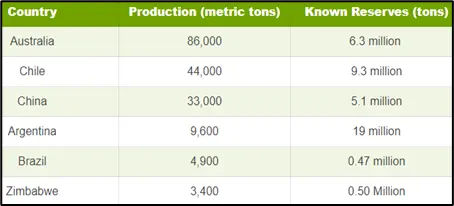
- Methods of Extraction:
Lithium mining primarily involves two techniques: brine extraction and hard-rock mining.- Brine Extraction: This method accounts for 66% of global lithium production. It involves pumping underground brine to the surface, where the water is allowed to evaporate, leaving behind lithium carbonate.
- Hard-Rock Mining: This method involves extracting lithium-bearing minerals from rock through conventional mining techniques.
- Production Trends:
Lithium production has seen a significant increase over the past decade.- Global Output: The global lithium production surpassed 100,000 metric tons for the first time in 2021, marking a fourfold increase from 2010.
- 2022 Production: In 2022, the estimated global production of lithium was approximately 130,000 metric tons.
Lithium Reserves and Mining in India:
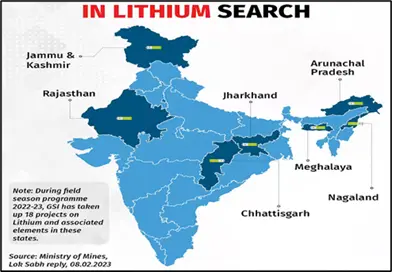
Lithium Reserves and Mining Challenges in India:
- Discovery of Lithium Reserves:
- Jammu and Kashmir: The Geological Survey of India (GSI) first identified lithium inferred resources of 5.9 million tonnes in Reasi district, Jammu and Kashmir.
- Rajasthan: GSI subsequently discovered a larger reserve of lithium in Degana, Nagaur district, Rajasthan. This reserve is estimated to be capable of meeting 80% of India’s total lithium demand.
- Auction of Lithium Block: The Ministry of Mines has auctioned India’s first lithium block located in Korba district, Chhattisgarh (Katghora region).
- Environmental Challenges of Lithium Mining:
- Water Depletion: Extracting one ton of lithium requires around 500,000 litres of water, leading to significant depletion of water resources in arid regions and affecting local communities and ecosystems.
- Soil and Water Contamination: The extraction process involves chemicals like sulfuric acid, which can contaminate soil and water sources, posing risks to human health and wildlife.
- Carbon Emissions:
- Lithium mining, especially from hard rock sources, is energy-intensive, requiring substantial electricity for crushing, grinding, and chemical separation.
- This often relies on non-renewable energy sources, increasing carbon emissions and the carbon footprint of lithium production.
Fallouts of Lithium Mining in Chile:
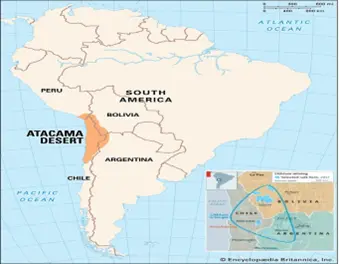
Impact of Lithium Mining:
- Environmental Fallouts:
- Global Perspective: Research indicates that lithium mining has led to significant environmental damage, particularly in countries such as Chile.
- Satellite Observations:
- Data Collection: Satellite data from 2020 to 2023 reveal deformations in the Earth's crust at the Atacama salt flat, one of the world’s largest lithium sources.
- Impacts of Mining Activities:
- Areas of Concern: The most severe deformations are observed in regions with intensive lithium-rich brine pumping.
- Cause of Subsidence: Rapid pumping of brine exceeds the natural recharge rate of aquifers, resulting in subsidence, or the downward vertical movement of the Earth's surface.
|
UPSC Civil Services Examination, Previous Year Question (PYQ) Prelims Q:1 Which one of the following pairs of metals constitutes the lightest metal and the heaviest metal, respectively? (2008)
Ans: (b)
Mains Q:1 Despite India being one of the countries of Gondwanaland, its mining industry contributes much less to its Gross Domestic Product (GDP) in percentage. Discuss. (2021) |
Source: IE
Polygraph Test
Why in the news ?
- Recently, the Central Bureau of Investigation (CBI) has been authorized to conduct a polygraph test on the main suspect in the rape and murder case involving a postgraduate doctor at Kolkata Medical College.
- This polygraph test is expected to assist investigators in verifying the consistency of the suspect’s statements and detecting any potential deception.
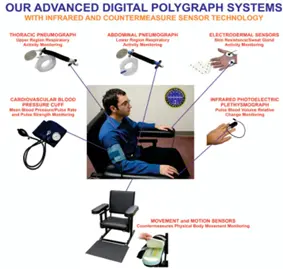
What is a Polygraph Test?
- About:
- Polygraph or Lie Detector Test: A procedure that measures and records various physiological indicators such as blood pressure, pulse, respiration, and skin conductivity while a person answers a series of questions.
- Assumption: The test is based on the premise that physiological responses triggered during deception differ from normal responses.
- Procedure: Numerical values are assigned to each physiological response to determine whether the person is truthful, deceptive, or uncertain.
- Historical Context: A test similar to the polygraph was first conducted in the 19th century by Italian criminologist Cesare Lombroso, who used a machine to measure blood pressure changes in criminal suspects during interrogation.
- Different from Narco-Analysis Test:
- Narco-Analysis: Involves administering sodium pentothal to the accused, inducing a hypnotic or sedated state believed to neutralise imagination, rendering the individual incapable of lying and more likely to reveal truthful information.
- Accuracy of Tests:
- Controversial Nature: Polygraph and narco tests are not scientifically validated as 100% accurate and remain contentious within the medical community.
- Use in Investigations: Despite the controversy, investigative agencies have increasingly used these tests as a "softer alternative" to torture for extracting truth from suspects.
- Note:
- Brain Mapping: A test that uses imaging to study the brain's anatomy and function, helping doctors assess if brain function is normal and identifying areas controlling movement, speech, and vision.
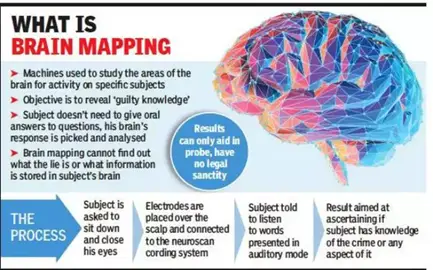
What is the Legal Admissibility of a Polygraph Test?
- Violation of Article 20(3):
- Article 20(3): Polygraph, narco-analysis, and brain mapping tests conducted without the accused’s consent violate Article 20(3) of the Indian Constitution, which protects against self-incrimination.
- Protection: This article ensures that no individual accused of an offence is compelled to testify against themselves.
- Necessity of Consent:
- Mandatory Consent: As these tests involve the accused providing potentially self-incriminating information, their consent is required to avoid breaching constitutional rights.
- Judicial and Human Rights Concerns:
- Rights and Freedoms: The use of narco-analysis and similar tests raises significant concerns about judicial integrity and human rights, particularly with respect to individual rights and freedoms.
- Criticism from Courts:
- Violation of Rights: Courts have frequently criticized these tests as they can constitute mental torture, infringing on the right to life and privacy guaranteed under Article 21 of the Constitution.
What are the Landmark Judgments Related to Polygraph Tests?
- Selvi v. State of Karnataka & Anr (2010):
- SC Ruling: The Supreme Court ruled on the legality and admissibility of narco tests, stating that involuntary administration of narco or lie detector tests constitutes an intrusion into an individual’s "mental privacy."
- Fundamental Right: The court held that narco tests violate the fundamental right against self-incrimination under Article 20(3), which ensures that no person accused of an offence shall be compelled to be a witness against themselves.
- Self-Incrimination: A legal principle where a person cannot be forced to provide information or testify against themselves in a criminal case.
- D.K. Basu v. State of West Bengal (1997):
- SC Ruling: The Supreme Court ruled that the involuntary administration of polygraph and narco tests amounts to cruel, inhuman, and degrading treatment under the context of Article 21, which protects the Right to Life and Liberty.
- State of Bombay v. Kathi Kalu Oghad (1961):
- SC Ruling: The Supreme Court of India determined that the right against self-incrimination under Article 20(3) does not extend to physical evidence (e.g., fingerprints, handwriting, blood, and voice samples), voluntarily given information, and identification procedures (e.g., line-ups and photo arrays).
- Other Observations by the SC:
- Reliability: The SC noted that narco tests are neither reliable nor conclusive as evidence, as they are based on assumptions and probabilities.
- Admissibility: Information or material discovered with the help of voluntarily administered test results can be admitted under Section 27 of the Evidence Act, 1872 (now Bharatiya Sakshya Adhiniyam).
- Section 27 of the Evidence Act:
- Allows admissibility of information provided by an accused in police custody if it leads to the discovery of a fact.
- Only the portion of information directly related to the discovered fact can be proven, irrespective of whether it amounts to a confession.
- NHRC Guidelines: The court emphasised that the ‘Guidelines for the Administration of Polygraph Test on an Accused,’ published by the National Human Rights Commission (NHRC) in 2000, must be strictly followed.
What NHRC Guidelines on Polygraph Tests ?
- Voluntary Consent:
- Accused’s Agreement: The accused must voluntarily agree to undergo the polygraph test, with the option to refuse.
- Informed Consent:
- Awareness: Before agreeing, the accused should be fully informed by the police and their lawyer about the test’s purpose, procedure, and legal consequences.
- Recorded Consent:
- Formal Record: The accused’s consent must be formally recorded in the presence of a Judicial Magistrate.
- Documentation:
- Court Proceedings: During court proceedings, the police must provide evidence that the accused voluntarily agreed to the test, documented by the lawyer and presented to the judge.
- Clarification of Statements:
- Statements during Test: The accused should be made aware that any statements made during the polygraph test are treated as statements to the police, not as confessions.
- Judicial Consideration:
- Evaluation Factors: Judges consider various factors, such as the length of the accused’s detention and the nature of the interrogation, when evaluating the results of a polygraph test.
Classical Languages
Why in the news ?
- Recently, the centres for the promotion of classical Telugu, Odia, Kannada, and Malayalam have demanded autonomy for their effective functioning.

- Classical Language Status Criteria
- Historical Continuity: The language must have a documented history spanning at least 1,500-2,000 years, evident in early texts.
- Cultural Heritage: It should possess a significant body of ancient literature that is esteemed as a cultural heritage by generations of its speakers.
- Literary Originality: The language's literary tradition should be original and not derived from another speech community.
- Distinctiveness: There should be a clear distinction between the classical language and its modern form, potentially indicating a discontinuity between the classical language and its later forms or offshoots.
- Recognized Classical Languages : India currently recognizes the following six classical languages:
- Tamil (2004)
- Sanskrit (2005)
- Telugu (2008)
- Kannada (2008)
- Malayalam (2013)
- Odia (2014)
- Benefits of Classical Language Status
- International Awards: Two major international awards are given annually to scholars of eminence in the language.
- Centre of Excellence: Establishment of a Centre of Excellence for Studies in the Classical Language.
- Academic Promotion: The University Grants Commission (UGC) is requested to establish Professional Chairs in Central Universities dedicated to the classical language.
Source: TH
National Quantum Mission (NQM)
Why in the news ?
- Recently, India’s first quantum computer was set for launch under the National Quantum Mission.

Objective
- The National Quantum Mission (NQM) aims to advance India's quantum technologies across four key verticals: quantum computing, communication, measurement, and sensing. This comes after a delay of nearly four years.
Funding & Structure
- Funding: The mission has been allocated nearly ₹6,000 crore.
- Structure: Plans include establishing four Section 8 companies under premier institutions like IITs and IISc, which will lead activities across the identified verticals.
About National Quantum Mission (NQM)
- Launch: The National Quantum Mission (NQM) was launched in 2023.
- Lead Agency: Department of Science and Technology (DST).
- Duration: The mission spans over eight years (2023-2031).
- Goals:
- Development of intermediate-scale quantum computers with 50-1000 physical qubits using platforms like superconducting and photonic technology.
- Establishment of satellite-based secure quantum communications, with a range of 2000 km within India and extension to other countries.
- Development of highly sensitive magnetometers in atomic systems and precision atomic clocks for timing, communication, and navigation.
- Design and synthesis of quantum materials such as superconductors, novel semiconductor structures, and topological materials to fabricate advanced quantum devices.
Thematic Hubs (T-Hubs)
- Focus: Four T-Hubs will be instituted in premier academic and national research and development institutes.
- Purpose: These hubs will ignite new knowledge through fundamental and applied research and drive R&D activities forward.
Applications: The mission will have applications across various sectors, including:
- Healthcare and diagnostics
- Defence
- Energy
- Data security
How Do Quantum Computers Work?
- Qubit: Quantum computing uses the qubit as the basic unit of information instead of the conventional bit.
- Superposition: The key characteristic of quantum computing is the coherent superposition of ones and zeros, enabling complex computations beyond the capabilities of classical computers.
Source: BS
Acute Encephalitis Syndrome (AES)
Why in the news ?
- Acute Encephalitis Syndrome (AES), Recently cases surged in Gujarat, leading to a significant health crisis that predominantly affected children and resulted in multiple fatalities.
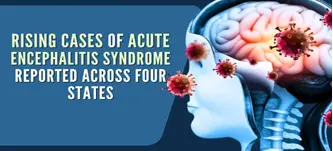
About Acute Encephalitis Syndrome (AES):
- Characteristics:
- AES is marked by the sudden onset of high-grade fever, convulsions, altered sensorium, and multi-organ dysfunction.
- Additional symptoms often include vomiting, diarrhoea, and, in severe cases, respiratory failure with nasal bleeding.
- Causes:
- The syndrome can be triggered by various pathogens, including viruses, bacteria, fungi, and parasites, as well as exposure to toxins and chemicals.
- Diagnosis Challenges:
- Diagnosing AES is complicated due to symptom overlap with other viral infections such as Chandipura Vesiculovirus (CHPV), Enterovirus, Meningitis, and Japanese Encephalitis.
Specifics of the Gujarat Outbreak:
- Geographical Spread:
- The outbreak affected 26 of Gujarat's 33 districts, impacting both rural and urban regions.
- Six major cities reported cases, with some patients arriving from neighbouring states like Rajasthan, Madhya Pradesh, and Maharashtra for treatment.
- Patient Zero:
- The first confirmed AES case in Gujarat involved a four-year-old girl from Aravalli district, who sadly passed away before a CHPV diagnosis could be confirmed.
- Fatalities and Caseload:
- As of August 19, 2024, Gujarat reported 178 AES cases, with 78 fatalities. Among the deceased, 28 children (36%) tested positive for CHPV, underscoring the outbreak's complexity.
Ministry-Wise Initiatives:
- Ministry of Health and Family Welfare: Strengthening and expanding JE (Japanese Encephalitis) vaccination programs, Enhancing public health interventions, Improving clinical management of JE/AES (Acute Encephalitis Syndrome) cases.
- Ministry of Jal Shakti: Ensuring the provision of safe drinking water.
- Ministry of Women and Child Development: Providing high-quality nutrition to vulnerable children.
- Ministry of Social Justice and Empowerment: Establishing District Disability Rehabilitation Centers (DDRCs) for disability management and rehabilitation.
- Ministry of Housing and Urban Affairs: Ensuring the supply of safe drinking water in slums and urban areas.
- Ministry of Education: Providing special educational facilities for children with disabilities.
Source: IE
Narcotics Control Bureau (NCB)
Why in the news ?
- Recently, The Union Home minister Amit Shaw inaugurated the zonal office of the Narcotics Control Bureau in Chhattisgarh's Raipur.

About Narcotics Control Bureau (NCB):
- Constitution and Headquarters:
- Established on 14th November 1985, the Narcotics Control Bureau (NCB) operates under the Ministry of Home Affairs, Government of India.
- It was constituted under the Narcotic Drugs and Psychotropic Substances Act, 1985 (NDPS Act).
- The NCB's headquarters are located in Delhi.
- Functions and Responsibilities:
- Coordination of Actions: The NCB coordinates actions by various offices, State Governments, and other authorities under the NDPS Act, Customs Act, Drugs and Cosmetics Act, and any other applicable laws for enforcing provisions of the NDPS Act, 1985.
- International Obligations: It implements countermeasures against illicit traffic in compliance with international conventions and protocols that are currently in force or may be ratified by India in the future.
- International Assistance: The NCB provides assistance to foreign authorities and international organisations to facilitate global coordination and action for the prevention and suppression of illicit drug trafficking.
- Domestic Coordination: It coordinates actions with other ministries, departments, and organisations on matters related to drug abuse.
- Enforcement and Intelligence:
- The NCB functions as an enforcement agency through its zonal offices.
- Zonal Offices: These offices collect and analyse data on narcotic drug and psychotropic substance seizures, study trends and modus operandi, disseminate intelligence, and cooperate closely with Customs, State Police, and other law enforcement agencies.
Source: BS
Mass Wasting
Why in the news ?
- Recently, A new study on the high frequency of mass wasting events in the Sedongpu Gully of the Tibetan Plateau since 2017 with more than 68% of the total 19 identified mass-wasting events occurring in this period.
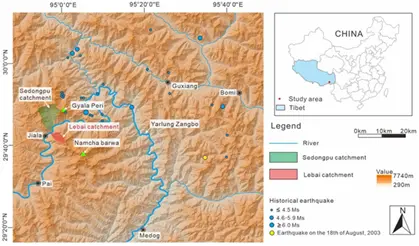
About Mass Wasting:
- Definition and General Characteristics:
- Mass wasting refers to the downslope movement of rock and soil under the influence of gravity.
- It is driven by gravity and occurs when slope stability is compromised.
- Causes of Mass Wasting:
- Slope Stability: Mass wasting occurs when a slope becomes too steep to remain stable with the existing material and conditions.
- Factors Influencing Stability: The stability of a slope is determined by the angle of the slope and the shear strength of the accumulated materials.
- Triggers: Common triggers include rapid snow melt, intense rainfall, earthquake shaking, volcanic eruptions, storm waves, stream erosion, and human activities. Excessive precipitation is the most common trigger.
- Types of Mass-Wasting Events:
- Classification: Mass-wasting events are classified based on the type of movement and material involved. They exhibit common morphological surface features.
- Common Types:
- Rockfalls: Movement of loose material or blocks of bedrock.
- Slides: Sudden movement of rock and soil down a slope.
- Flows: Dominantly liquid material movement, such as debris flows.
- Creep: Slow, gradual movement of soil and rock.
- Geological Terms:
- Landslides: A general term for fast-moving geologic material during mass wasting.
- Rock Topples/Rock Slides/Rock Falls: Terms used depending on the dominant motion of moving blocks of bedrock.
- Movement Rates and Hazards:
- Mass-wasting movements can be slow or rapid. Rapid movements, such as debris flows, can be particularly dangerous.
|
Sedongpu Gully and the Great Bend of the Tsangpo River:
|
Source: TH
US-India relations an upward Arc
Context:
- India has successfully deepened its ties with the US across trade, technology, and security under both Republican and Democratic administrations, unlike many American allies.
- India must leverage its strategic advantages—engagement with US policymakers, strong diaspora ties, and its role in the Indo-Pacific—to enhance and adapt this crucial relationship in a multipolar world.

Evolution of India-US Relations:
- From Estrangement to Engagement - The Cold War Thaw:
- During the Cold War, India and the US were on opposing sides, with India pursuing non-alignment and Pakistan aligning with the US.
- Relations began to improve in the 1990s with India’s economic liberalisation and the end of the Cold War.
- President Bill Clinton's 2000 visit marked a thaw, initiating strategic dialogues and economic cooperation.
- The 2004 Next Steps in Strategic Partnership (NSSP) solidified growing ties.
- Nuclear Breakthrough - A New Era of Trust:
- The 2008 Civil Nuclear Agreement was a key moment, ending India's nuclear isolation and integrating it into the global nuclear order.
- This agreement led to enhanced cooperation in defence and high-technology sectors and demonstrated US commitment to India's global stature.
- Defence Ties - From Buyer to Partner:
- Since the early 2000s, defence cooperation has surged. By 2016, the US designated India as a Major Defense Partner.
- The 2018 Strategic Trade Authorization tier 1 status allowed India licence-free access to military technologies.
- Foundational agreements like LEMOA (2016), COMCASA (2018), and BECA (2020) facilitated deeper military ties, supported by joint exercises and the 2+2 Ministerial Dialogue.
- Economic Synergy - Beyond Trade to Strategic Cooperation:
- Bilateral trade reached USD 118.28 billion in 2023-24, with the US becoming India's largest trading partner and major FDI source.
- Cooperation has expanded into clean energy, digital economy, and healthcare, highlighted by initiatives like the US-India Strategic Clean Energy Partnership (SCEP) and Covid-19 vaccine collaboration.
- Collaborating in the Digital Age:
- Technology cooperation is a cornerstone, with forums established for AI, quantum computing, and 5G collaboration.
- The US-India Science and Technology Endowment Fund (2009) has fostered innovation, with recent initiatives like the US-India Artificial Intelligence Initiative and Critical and Emerging Technology Initiative (iCET) launched in 2022.
- Geopolitical Alignment - Partners in the Indo-Pacific:
- The rise of China has aligned India and the US strategically, reflected in the revived Quad (India, US, Japan, Australia) and India's inclusion in the US Indo-Pacific strategy.
- Joint statements and initiatives like the Supply Chain Resilience Initiative underscore the depth of geopolitical cooperation.
Major Areas of Friction in India-US Relations:
- Trade Tensions - Navigating Economic Choppy Waters:
- Economic frictions include India’s trade surplus (USD 36.74 billion in 2023-24), market access barriers, and intellectual property rights concerns.
- The US criticises India's data localization policies and e-commerce regulations; India objects to US tariffs on steel and aluminium.
- The 2019 removal of India from the Generalised System of Preferences (GSP) and ongoing WTO disagreements over agricultural subsidies further complicate trade relations.
- Strategic Autonomy vs. Alliance Expectations:
- India's strategic autonomy often clashes with US expectations, particularly regarding the Russia-Ukraine conflict, where India has not condemned Russia and continues to buy Russian military equipment and oil.
- The threat of CAATSA sanctions and India's participation in groupings like BRICS and SCO, which include US adversaries, create friction.
- Technology Transfer and Defense Cooperation:
- Despite improved defence ties, technology transfer and joint production issues persist due to US export control regulations and delays in implementing agreements like COMCASA and BECA.
- The Defense Technology and Trade Initiative (DTTI) aims to address these issues, but progress has been slow.
- Human Rights and Democratic Values:
- US concerns over human rights issues in India, including religious freedom and treatment of minorities, occasionally strain relations.
- Recommendations from the US Commission on International Religious Freedom to designate India as a "country of particular concern" highlight these tensions.
- India views such criticisms as interference in its internal affairs, and balancing strategic partnership with values-based diplomacy remains challenging.
- Visa and Immigration:
- Changes to H-1B visa rules and the backlog for employment-based green cards disproportionately affecting Indians cause concern.
- Over 1 million Indians are waiting for highly skilled immigrant visas, creating friction in immigration policies.
- Climate Change and Energy:
- Differences persist over climate action, with the US pushing for more ambitious emission reduction targets and India emphasising development needs and financial support from developed nations.
- Disagreements include carbon border taxes and the phasing out of coal.
- Intellectual Property Rights:
- Intellectual property rights (IPR) issues include US concerns over India's patent laws, copyright piracy, and trademark infringement.
- India’s use of compulsory licensing for pharmaceuticals and stance on agricultural patents have been points of contention.
- Despite efforts to strengthen its IPR regime, differences in innovation and technology access persist.
How Can India Further Enhance Its Relations with the US?
- "Make in India" Meets "Buy American":
- India can propose joint manufacturing ventures in sectors like electronics, pharmaceuticals, and defence, aligning with both countries' economic goals.
- Implementing a fast-track approval process and creating special economic zones for US companies could enhance attractiveness.
- This initiative could address US job creation concerns and boost India's manufacturing capabilities.
- Green Energy Corridor:
- India can propose a bilateral Green Energy Corridor for developing renewable energy technologies, including solar, wind, and hydrogen.
- Collaborative research, manufacturing ventures, and sustainable urban development projects could be part of this initiative.
- Leveraging US expertise and India's scale could accelerate clean energy transitions and offer preferential market access for green technologies.
- Digital Democracy Initiative:
- Initiating a Digital Democracy Initiative with the US could focus on shared norms and technologies for a secure internet.
- Joint efforts in cybersecurity, disinformation countermeasures, and digital literacy, as well as privacy-preserving technologies, could be key components.
- This initiative could align digital governance approaches and address US tech policy concerns while bridging the digital divide.
- Skills Passport Program:
- India can propose a Skills Passport Program with standardised skill certification, streamlined visa processes, and joint training programs.
- Targeting high-demand sectors like healthcare, IT, and advanced manufacturing could be beneficial.
- The program could address labour shortages, brain drain concerns, and facilitate circular migration.
- Strategic Resource Partnership:
- India can become a key partner in securing and diversifying US supply chains for critical resources.
- This could involve joint exploration, production of rare earth elements, research on alternative materials, and stockpiling strategic resources.
- Fast-track environmental clearances and fiscal incentives could accelerate this partnership.
- Pandemic Preparedness and Beyond:
- Building on Covid-19 cooperation, India can propose a Health Security Alliance for joint vaccine development, research on infectious diseases, and early warning systems.
- Extending to telemedicine, medical device development, and health data analytics could create a robust partnership.
- Reciprocal recognition of medical qualifications and streamlined research approval could strengthen the alliance.
- Space Commercialization Consortium:
- India can initiate a Space Commercialization Consortium with the US for joint development of space technologies and services.
- Collaborative projects could include small satellite development, space-based internet, and space tourism technologies.
- Combining ISRO's cost-effective approach with NASA's capabilities and offering preferential launch services could accelerate commercialization.
- AgriTech Innovation Hub:
- Establishing an AgriTech Innovation Hub with the US could focus on advanced agricultural technologies, such as climate-resilient crops and precision farming.
- Joint research and AI-driven pest management systems, along with field testing and farmer exchange programs, could enhance food security.
- Leveraging US research capabilities and India's agro-climatic diversity could drive innovations in agriculture.
|
UPSC Civil Services Examination, Previous Year Question (PYQ) Mains Q:1 ‘What introduces friction into the ties between India and the United States is that Washington is still unable to find for India a position in its global strategy, which would satisfy India’s National self-esteem and ambitions’. Explain with suitable examples. (2019) |
Source: IE
Share the article
Edukemy’s Current Affairs Quiz is published with multiple choice questions for UPSC exams
MCQ
Get Latest Updates on Offers, Event dates, and free Mentorship sessions.

Get in touch with our Expert Academic Counsellors 👋
FAQs
UPSC Daily Current Affairs focuses on learning current events on a daily basis. An aspirant needs to study regular and updated information about current events, news, and relevant topics that are important for UPSC aspirants. It covers national and international affairs, government policies, socio-economic issues, science and technology advancements, and more.
UPSC Daily Current Affairs provides aspirants with a concise and comprehensive overview of the latest happenings and developments across various fields. It helps aspirants stay updated with current affairs and provides them with valuable insights and analysis, which are essential for answering questions in the UPSC examinations. It enhances their knowledge, analytical skills, and ability to connect current affairs with the UPSC syllabus.
UPSC Daily Current Affairs covers a wide range of topics, including politics, economics, science and technology, environment, social issues, governance, international relations, and more. It offers news summaries, in-depth analyses, editorials, opinion pieces, and relevant study materials. It also provides practice questions and quizzes to help aspirants test their understanding of current affairs.
Edukemy's UPSC Daily Current Affairs can be accessed through:
- UPSC Daily Current Affairs can be accessed through Current Affairs tab at the top of the Main Page of Edukemy.
- Edukemy Mobile app: The Daily Current Affairs can also be access through Edukemy Mobile App.
- Social media: Follow Edukemy’s official social media accounts or pages that provide UPSC Daily Current Affairs updates, including Facebook, Twitter, or Telegram channels.

